1. Calcium in poultry nutrition
Calcium (Ca) is an essential mineral for skeletal development and physiological processes including blood clotting, muscle contraction, nerve impulse transmission, enzyme activation, metabolic reactions, protein synthesis, and the maintenance of osmotic and acid-base balance (Crenshaw, 2001; Coon et al., 2002; Anwar, 2017). A deficiency in calcium can result in severe skeletal disorders such as rickets, tibial dyschondroplasia, bone fractures, and poor feather condition (Selle et al., 2009; Abdollahi et al., 2015). To prevent these complications and support healthy growth, it is essential to ensure adequate calcium levels in the diet. However, an excess would mean negative interactions between Ca and the absorption/ utilization of other essential minerals (Anwar, 2017).
Because of the physiological and metabolic differences between broilers and layers, this document focuses on advances in calcium utilization in broiler chickens.
1.1. Common sources of Calcium in poultry feed
Plant-based feed ingredients are naturally low in calcium, and to meet nutritional requirements inorganic Ca sources are used, such as limestone, dicalcium and monocalcium phosphate (Anwar, 2017; Kiarie & Nyachoti, 2010; González-Vega and Stein 2014) (Table1).
Table 1: Calcium average concentration in common feedstuffs used in poultry diets
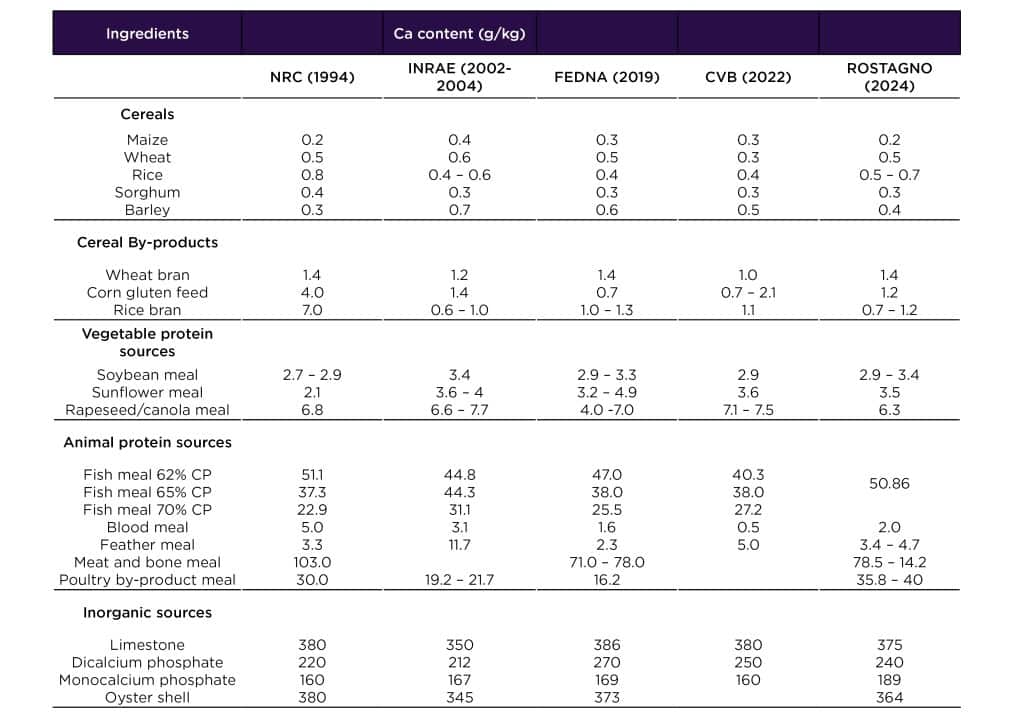
The main source of calcium in poultry diets is limestone, supplying up to 70% of total Ca requirement, due to its high Ca content (~380 g/kg) and low cost. Yet, its solubility and digestibility can be influenced by factors such as particle size and origin (Gilani et al., 2022; Cheng & Coon, 1990; Zhang & Coon, 1997).
These different factors contribute to an oversupply of Ca in feed. A study by Walk (2016) analyzed 795 broiler and swine diets from 2010 to 2015, revealing an average of 25% more calcium than formulated. This means that if a diet was formulated to contain 0.80% total Ca, the analyzed value could be as high as 1.02% or almost 25% above the expected dietary Ca concentration (Figure 1).
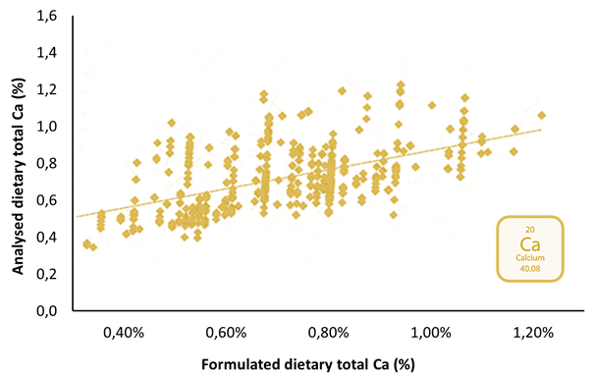
Figure 1: Scatter chart representing formulated and analyzed total dietary calcium in broiler and pig diets (n=795) (Walk, 2016)
These differences are due to the uncontrolled use of Ca, driven by its low cost and its presence in other feed components (e.g. premixes or as anti-caking and flow agent in SBM) (Ravindran et al., 2014; Tamim et al., 2004). These excesses may have implications for gastrointestinal pH and for phosphorus digestibility (David et al, 2021; González-Vega & Stein, 2014; Walk et al., 2012).
2. No Calcium without Phosphorus: A nutritional interdependence
Calcium and phosphorus are fundamental minerals for broiler growth and skeletal development (Abdollahi, 2015). Their physiological roles are linked because of their close interaction which influences the absorption and utilization of both minerals.
Most of the P derived from plant-based ingredients is in the form of phytate phosphorus (PP) which is poorly available, and its concentrations may vary greatly depending on the ingredients used. Phytate (myo-inositol hexaphosphate; IP-6) is a strong chelating agent, binding strongly to divalent cations, proteins, starch and enzymes (Figure 2).
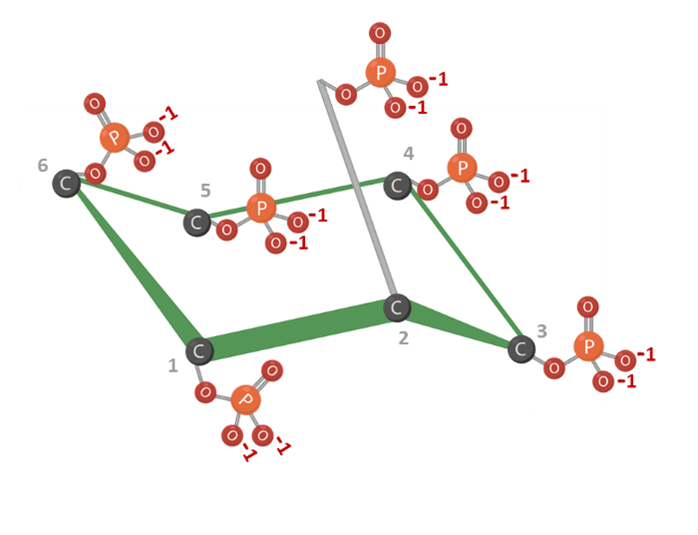
Figure 2: Phytic acid (myo-inositol hexaphosphate; InsP6). InsP6 in an extremely basic environment, showing a high anionic charge. Created in BioRender.com
2.1. Interaction with phosphorus
Calcium, particularly when supplied in excess, can negatively affect the digestive process by limiting the availability of nutrients specifically minerals and lipids, and impair growth performance. This effect is primarily due to the formation of insoluble Ca–phytate–protein complexes, a saturable reaction dependent on both calcium ion (Ca²⁺) and phytic acid concentrations (Nelson et al., 1968; Kim et al., 2018) (Figure 3).
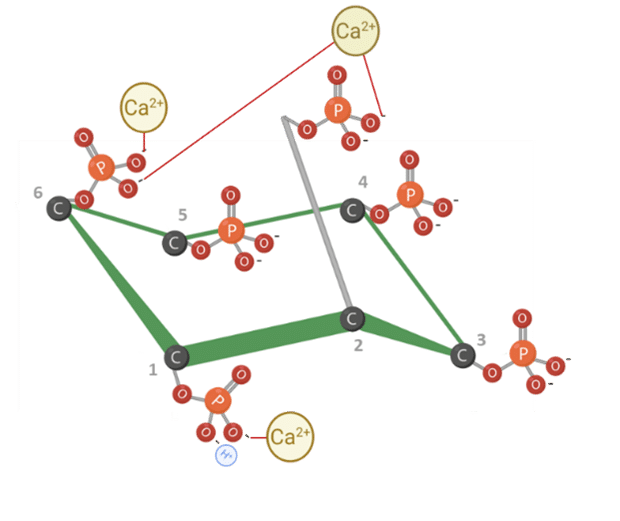
Figure 3: Ca–phytate insoluble complexes. Created in BioRender.com.
Although calcium has one of the lowest affinities for chelating with phytate compared to other inorganic minerals (Zn²⁺ > Fe²⁺ > Mn²⁺ > Fe³⁺ > Ca²⁺ > Mg²⁺), and thus a relatively low inhibitory potential on PP hydrolysis, its significant impact is largely due to the high calcium content (8.0 – 10.0 g/kg) in broiler diets. As a result, the greater the Ca:Phytate molar ratio, the more likely calcium–phytate interactions will occur (Angel et al., 2002; Tamim et al., 2004; Selle et al., 2009; Driver et al., 2005; de Matos, 2008; Maenz et al., 1999).
2.2. Influence on gastrointestinal pH
Limestone possess a high and variable acid-binding capacity (12 932 ± 21 883 mEq/kg) (Lawlor et al., 2005), which increases digesta pH along the gut (Wilkinson et al., 2013; Walk et al., 2012). Higher pH levels promotes the formation of mineral-phytate complexes, as the precipitation of these complexes in the upper intestine is pH dependent.
3. Strategies to limit the antinutritional effect of Calcium
3.1. Exogenous phytases
Since PP is poorly available, microbial phytases are added to enhance the bioavailability of phosphorus bound to phytate. One of the key challenges is that high dietary calcium can increase the amount of the phytate-mineral complexes, which reduces their surface area and makes them less accessible to enzymatic hydrolysis. Although phytase has been shown to improve calcium digestibility, elevated calcium levels can reduces its enzymatic activity in the intestinal tract (Angel et al., 2002; Applegate et al., 2023).
3.2. Digestible Calcium
Calcium digestibility received little attention due to the abundance and low cost of limestone. However, the growing focus on digestible phosphorus has prompted a reevaluation of Ca digestibility and inclusion. Several dietary and animal-related factors influence Ca digestibility. For instance, David et al. (2020) demonstrated that apparent ileal Ca digestibility decreased linearly with broiler age. The first step is to generate data on the ileal digestibility of Ca, and research is still ongoing.
3.3. Calcium Humophosphate
Calcium can exhibit antinutritional properties by reducing the availability of PP & other essential nutrients. When insoluble calcium-phytate complexes are formed, phytase enzymes can no longer hydrolyze phytate to release phosphorus.
Among the strategies to mitigate calcium’s antinutritional effects, one promising approach is the inclusion of calcium humophosphate (branded under the name “HumIPHORA”) in monogastric diets. HumIPHORA is produced through a chemical reaction involving phosphoric acid, a calcium source, and humic substances. It provides 22% of phosphorus and 15% of calcium.
Humic substances are complex organic compounds derived from the decomposition of organic matter in soil. Although humic substances are not classified as nutrients, they are valued for their contribution to improving phosphorus digestibility. Several studies have highlighted the beneficial effects of humic substances on nutrient utilization and gut health in various animal species (Arif et al., 2019). In broiler chickens, humic substances have been shown to enhance feed digestibility by supporting a healthy intestinal microbiota, forming a protective layer on the intestinal mucosa, and improving nutrient absorption (Arif et al., 2019).
The colloidal nature of humic substances and their ability to form chelates with various ions have been associated with improved mineral utilization in animals. These properties have been linked to enhanced tibia ash content and mineral retention (Marcinčák et al., 2023). Specifically, their chelating ability allows them to act as a calcium “trap,” reducing the formation of insoluble mineral complexes, particularly those involving calcium and phosphorus. In essence, instead of calcium binding with phytic phosphorus, it partially binds with the humic component of calcium humophosphate. This reduces calcium’s interference with phosphorus absorption and phytase activity, thereby enhancing the digestibility of plant-based phosphorus.
A trial conducted in collaboration with the University of Madrid supports this mechanism of action, showing improved digestibility of phosphorus, dry matter, and organic matter in diets containing HumIPHORA compared to those with monocalcium phosphate (MCP). Organic matter digestibility, in this context, reflects improved utilization of amino acids and proteins (Figure 5).
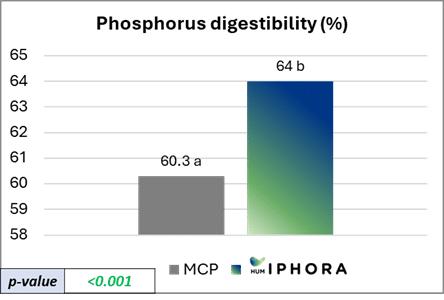
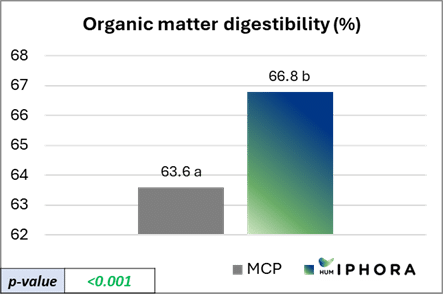
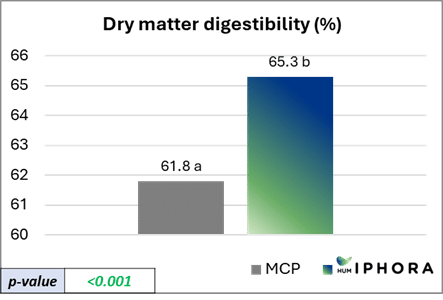
Figure 5: Effect of the inclusion of HumIPHORA in broiler diets on P, organic matter and dry matter digestibility.